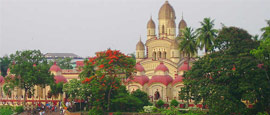The city's main museum has an enthralling (and huge) range of artefacts spread over several galleries devoted to archaeology, art, anthropology, geology, zoology and botany. Highlights include a prized collection of Buddhist art, rare paintings, an Egyptian mummy, and a reproduction of the Barhut Gateway, dating back to second century BC. Indeed, the museum itself is a piece of history, with the building dating back to 1875.
Things to see in Kolkata (Calcutta)
Tourist offices
Address: 3/2 B.B.D Bag, Kolkata, 700001, India
Tel: +91 33 22436440.
Opening Hours:
Mon-Fri 1000-1700
www.wbtourism.gov.inAn important pilgrimage centre for Hindus, the original temple is supposed to have been built 350 years ago; this one dates back to 1809. Legend says that when the corpse of Sati, wife of Lord Shiva, was cut into pieces by Sidarshan Chakra, one of her toes fell here. Believed to be the original temple from the village of Kolikata, from where Kolkata took its name, this is a mind-stirring, if rather grim place; goats are regularly slaughtered here to honour the destroyer goddess Kali.
Built from white marble and situated at the south end of the Maidan, this huge domed colonial building blends a combination of classical European architecture with Mughul influences to create one of the city's greatest landmarks. It is home to thousands of artefacts relating to the British Raj and other chapters of Indian history.
A riveting glimpse of colonial history and architecture is on display in this area, once known as Dalhousie Square but renamed Benoy Badal Dinesh Bagh after three freedom fighters, the martyrs of Bengal. When Queen Victoria took over the administration of India from the East India Company, Kolkata became the capital of British India.
On the north side is the huge Writers' Building, housing the Secretariat of the Government of West Bengal and on the south side is Raj Bhavan, residence of the Governor of West Bengal.
On the banks opposite Belur Math (a boat links the two) to the north of the city lies the spot where Ramakrishna achieved a spiritual vision of equality of all religions. Dedicated to the Hindu goddess Kali, the temple was built in 1847, and also contains 12 smaller temples in the courtyard dedicated to Shiva, Radha and Krishna. It's usually crowded.
The headquarters of the Ramakrishna Mission (named after the 19th-century Indian philosopher Ramakrishnan, preacher of unity of all religions), this centre synthesises the architectural styles of Christianity, Islam and Hinduism to create a peaceful and meditative atmosphere. The complex was consecrated in 1898 by one of his disciples.
Kolkata's principal place of Christian worship, and one of the most important in India, St Paul's was originally constructed between 1839 and 1847, but has been rebuilt several times due to damage caused by earthquakes. Modelled on St Martin-in-the-Fields, London, it is chiefly noted for its impressive stained-glass windows.
This is one of the world's largest city parks, the 'lungs' of Kolkata, and home to the Victoria Memorial, Fort William and Eden Gardens. Also inside is the international cricket stadium, Ranji Stadium, home to the nation's greatest sporting passion. Eden Gardens contains a small lake and a pagoda purchased from Myanmar in 1856.
Once a private home, this extraordinary building has a wonderful collection of statues, paintings and antiquities from the private collection of Raja Rajendra Mullick, including paintings by Rubens and Joshua Reynolds. Famous for its marble walls and floors, this striking mansion was constructed in the mid 19th century and sports some impressive architecture. To visit, a permit is required from the West Bengal Tourism Centre.
This peaceful place was first opened in 1767, when burials took place after dark with the aid of lit torches and sometimes included the pageantry of a military funeral, mainly to accommodate the large number of British who died serving their country. The cemetery is tranquil, lush, and deserted, with huge obelisks, pyramids and classical mausoleums of all shapes and sizes, set amidst gracious gardens. Job Charnock, the city's founder, is buried here and the cemetery is also home to a memorial dedicated to those who lost their lives in the 'Black Hole'.
Do you have any Feedback about this page?
© 2025 Columbus Travel Media Ltd. All rights reserved. No part of this site may be reproduced without our written permission, click here for information on Columbus Content Solutions.








 You know where
You know where